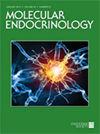一氧化氮在POMC下丘脑神经元中发挥基础和胰岛素依赖性的缺氧作用。
Q Biochemistry, Genetics and Molecular Biology
引用次数: 18
摘要
下丘脑的弓形核是控制食欲和摄食的关键中枢,通过调节2个关键的神经元群,特别是阿戈提相关肽/神经肽Y和原黑皮质素(POMC)/可卡因和安非他明调节的转录神经元。这些神经网络的调节改变,特别是POMC神经元在高脂肪消耗时的功能障碍,是肥胖和2型糖尿病发生的主要致病机制。为了预防或治疗这些代谢疾病,人们正在努力保持POMC神经元的完整性或增强其功能。在这里,我们首次报道了一氧化氮(NO(-))供体硝普钠(SNP)通过介导POMC水平上调介导下丘脑组织和下丘脑源性细胞模型中的厌氧性作用。在mHypoA-POMC/GFP-2细胞中,SNP以剂量依赖的方式增加POMC mRNA,并增强α-黑素皮质素分泌激素的产生和分泌。SNP也可能通过抑制sirtuin 1的去乙酰化酶活性来增强胰岛素驱动的POMC表达。此外,SNP增强了胰岛素依赖性POMC表达,可能是通过降低Foxo1对POMC基因的转录抑制。长期暴露于SNP可以防止胰岛素抵抗的发生。综上所述,NO(-)供体SNP通过促进POMC神经元独立或与胰岛素合作的转录表达来增强其厌氧性潜能。因此,增加细胞NO(-)水平代表了一种促进现有POMC神经元群厌氧性输出的激素独立方法,可能有利于对抗这些普遍疾病。本文章由计算机程序翻译,如有差异,请以英文原文为准。
Nitric Oxide Exerts Basal and Insulin-Dependent Anorexigenic Actions in POMC Hypothalamic Neurons.
The arcuate nucleus of the hypothalamus represents a key center for the control of appetite and feeding through the regulation of 2 key neuronal populations, notably agouti-related peptide/neuropeptide Y and proopimelanocortin (POMC)/cocaine- and amphetamine-regulated transcript neurons. Altered regulation of these neuronal networks, in particular the dysfunction of POMC neurons upon high-fat consumption, is a major pathogenic mechanism involved in the development of obesity and type 2 diabetes mellitus. Efforts are underway to preserve the integrity or enhance the functionality of POMC neurons in order to prevent or treat these metabolic diseases. Here, we report for the first time that the nitric oxide (NO(-)) donor, sodium nitroprusside (SNP) mediates anorexigenic actions in both hypothalamic tissue and hypothalamic-derived cell models by mediating the up-regulation of POMC levels. SNP increased POMC mRNA in a dose-dependent manner and enhanced α-melanocortin-secreting hormone production and secretion in mHypoA-POMC/GFP-2 cells. SNP also enhanced insulin-driven POMC expression likely by inhibiting the deacetylase activity of sirtuin 1. Furthermore, SNP enhanced insulin-dependent POMC expression, likely by reducing the transcriptional repression of Foxo1 on the POMC gene. Prolonged SNP exposure prevented the development of insulin resistance. Taken together, the NO(-) donor SNP enhances the anorexigenic potential of POMC neurons by promoting its transcriptional expression independent and in cooperation with insulin. Thus, increasing cellular NO(-) levels represents a hormone-independent method of promoting anorexigenic output from the existing POMC neuronal populations and may be advantageous in the fight against these prevalent disorders.
求助全文
通过发布文献求助,成功后即可免费获取论文全文。
去求助
来源期刊

Molecular endocrinology
医学-内分泌学与代谢
CiteScore
3.49
自引率
0.00%
发文量
0
审稿时长
12 months
期刊介绍:
Molecular Endocrinology provides a forum for papers devoted to describing molecular mechanisms by which hormones and related compounds regulate function. It has quickly achieved a reputation as a high visibility journal with very rapid communication of cutting edge science: the average turnaround time is 28 days from manuscript receipt to first decision, and accepted manuscripts are published online within a week through Rapid Electronic Publication. In the 2008 Journal Citation Report, Molecular Endocrinology is ranked 16th out of 93 journals in the Endocrinology and Metabolism category, with an Impact Factor of 5.389.
 求助内容:
求助内容: 应助结果提醒方式:
应助结果提醒方式:


